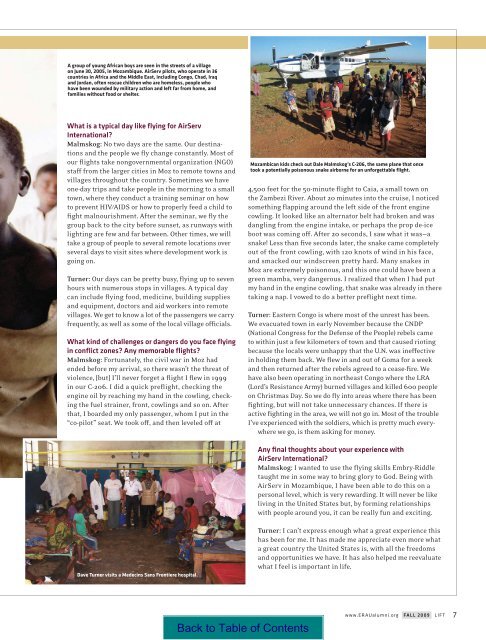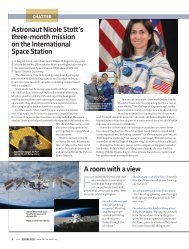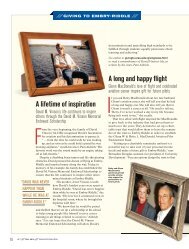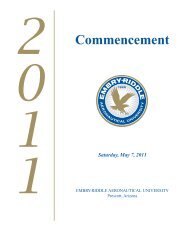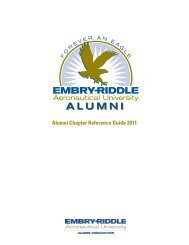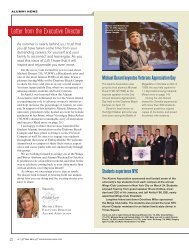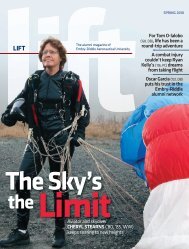Fall 2009 Issue - Embry-Riddle Aeronautical University Alumni
Fall 2009 Issue - Embry-Riddle Aeronautical University Alumni
Fall 2009 Issue - Embry-Riddle Aeronautical University Alumni
Create successful ePaper yourself
Turn your PDF publications into a flip-book with our unique Google optimized e-Paper software.
A group of young African boys are seen in the streets of a village<br />
on June 30, 2005, in Mozambique. AirServ pilots, who operate in 36<br />
countries in Africa and the Middle East, including Congo, Chad, Iraq<br />
and Jordan, often rescue children who are homeless, people who<br />
have been wounded by military action and left far from home, and<br />
families without food or shelter.<br />
What is a typical day like flying for AirServ<br />
International<br />
Malmskog: No two days are the same. Our destinations<br />
and the people we fly change constantly. Most of<br />
our flights take nongovernmental organization (NGO)<br />
staff from the larger cities in Moz to remote towns and<br />
villages throughout the country. Sometimes we have<br />
one-day trips and take people in the morning to a small<br />
town, where they conduct a training seminar on how<br />
to prevent HIV/AIDS or how to properly feed a child to<br />
fight malnourishment. After the seminar, we fly the<br />
group back to the city before sunset, as runways with<br />
lighting are few and far between. Other times, we will<br />
take a group of people to several remote locations over<br />
several days to visit sites where development work is<br />
going on.<br />
Turner: Our days can be pretty busy, flying up to seven<br />
hours with numerous stops in villages. A typical day<br />
can include flying food, medicine, building supplies<br />
and equipment, doctors and aid workers into remote<br />
villages. We get to know a lot of the passengers we carry<br />
frequently, as well as some of the local village officials.<br />
What kind of challenges or dangers do you face flying<br />
in conflict zones Any memorable flights<br />
Malmskog: Fortunately, the civil war in Moz had<br />
ended before my arrival, so there wasn’t the threat of<br />
violence, [but] I’ll never forget a flight I flew in 1999<br />
in our C-206. I did a quick preflight, checking the<br />
engine oil by reaching my hand in the cowling, checking<br />
the fuel strainer, front, cowlings and so on. After<br />
that, I boarded my only passenger, whom I put in the<br />
“co-pilot” seat. We took off, and then leveled off at<br />
Mozambican kids check out Dale Malmskog’s C-206, the same plane that once<br />
took a potentially poisonous snake airborne for an unforgettable flight.<br />
4,500 feet for the 50-minute flight to Caia, a small town on<br />
the Zambezi River. About 20 minutes into the cruise, I noticed<br />
something flapping around the left side of the front engine<br />
cowling. It looked like an alternator belt had broken and was<br />
dangling from the engine intake, or perhaps the prop de-ice<br />
boot was coming off. After 20 seconds, I saw what it was—a<br />
snake! Less than five seconds later, the snake came completely<br />
out of the front cowling, with 120 knots of wind in his face,<br />
and smacked our windscreen pretty hard. Many snakes in<br />
Moz are extremely poisonous, and this one could have been a<br />
green mamba, very dangerous. I realized that when I had put<br />
my hand in the engine cowling, that snake was already in there<br />
taking a nap. I vowed to do a better preflight next time.<br />
Turner: Eastern Congo is where most of the unrest has been.<br />
We evacuated town in early November because the CNDP<br />
(National Congress for the Defense of the People) rebels came<br />
to within just a few kilometers of town and that caused rioting<br />
because the locals were unhappy that the U.N. was ineffective<br />
in holding them back. We flew in and out of Goma for a week<br />
and then returned after the rebels agreed to a cease-fire. We<br />
have also been operating in northeast Congo where the LRA<br />
(Lord’s Resistance Army) burned villages and killed 600 people<br />
on Christmas Day. So we do fly into areas where there has been<br />
fighting, but will not take unnecessary chances. If there is<br />
active fighting in the area, we will not go in. Most of the trouble<br />
I’ve experienced with the soldiers, which is pretty much everywhere<br />
we go, is them asking for money.<br />
Any final thoughts about your experience with<br />
AirServ International<br />
Malmskog: I wanted to use the flying skills <strong>Embry</strong>-<strong>Riddle</strong><br />
taught me in some way to bring glory to God. Being with<br />
AirServ in Mozambique, I have been able to do this on a<br />
personal level, which is very rewarding. It will never be like<br />
living in the United States but, by forming relationships<br />
with people around you, it can be really fun and exciting.<br />
Dave Turner visits a Medecins Sans Frontiere hospital.<br />
Turner: I can’t express enough what a great experience this<br />
has been for me. It has made me appreciate even more what<br />
a great country the United States is, with all the freedoms<br />
and opportunities we have. It has also helped me reevaluate<br />
what I feel is important in life.<br />
www.ERAUalumni.org FALL <strong>2009</strong> LIFT 7


